Tales From the Wild Side
Summer 2020
Board of Directors
President (Interim) Henry Miller
Vice-President Mike Hammond
Secretary Gaby Emond
Treasurer Henry Van Ael
Committees
Newsletter Ilka Milne & Bob Saunders
Website Ilka Milne & Bob Saunders
Events Ilka Milne & Bob Saunders
Boardwalk Ahlan Johanson & Mike Hammond
Publicity Henry Miller & Ilka Milne
Stewardship Liaison Gaby Emond
Summer
I have to admit I am rather ambivalent about summer. Through the long winter and short spring we cant help dreaming about and planning for all the activities summer offers; hiking, biking, birding, canoeing, kayaking, chasing dragonflies and butterflies, hunting for rare plants, enjoying the progression of flowers as they bloom and fade and are replaced by new ones – the possibilities are endless. But the heat and humidity of summer here takes its toll, and the constant checking for ticks and the incessant drone of deerflies as they constantly circle about your head looking for places to bite take some of the enjoyment away from stepping outdoors. But those nuisances don’t last forever, and really, for the most part, that’s all they are.
I am not sure if it was a combination of last autumn’s rainy weather and this summer’s heat, but there seemed to be a difference from previous summers. Tick season began as usual in late April but had ended by the middle of July rather than the end of that month. Deerflies normally become a nuisance about the same time the ticks begin to disappear in late July, but this year they were out in force by early May and remained bothersome until the last two weeks in August, which was also unusual. In the past, they have remained in my area well into September at times.
As I write this, it is well into autumn. The ticks and deerflies have disappeared, the temperatures have cooled, and the promises of spring have faded into memories. It has been a most unusual summer in another respect. The arrival of the COVID-19 pandemic in early Spring put a quick end to many activities the club had planned, as well as numerous citizen science projects throughout the province. It is still uncertain when (and if) things will ever become normal again. Nevertheless, we will adapt, and will continue having new dreams and plans for next summer.
Poetry Corner
Fireflies in the Garden
Robert Frost (1874 – 1963)
Here come real stars to fill the upper skies,
And here on earth come emulating flies,
That though they never equal stars in size,
(And they were never really stars at heart)
Achieve at times a very star-like start.
Only, of course, they can’t sustain the part.

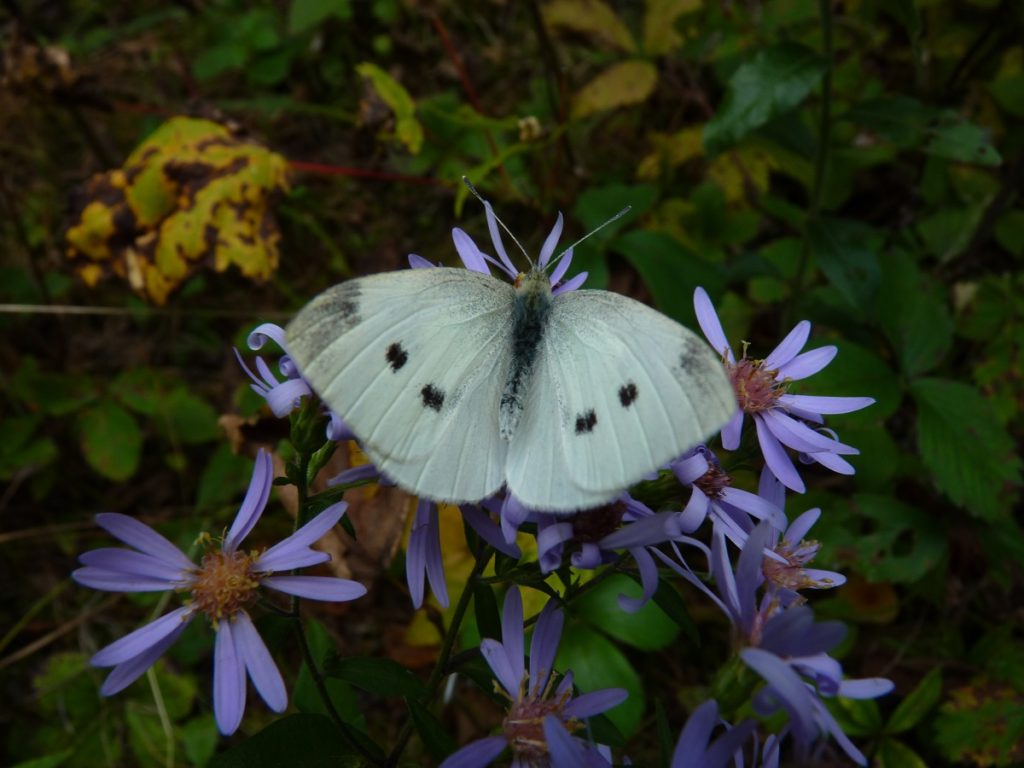
Summer of the Ladybirds
Vivian Smith (1933 -)
Can we learn wisdom watching insects now,
or just the art of quiet observation?
Creatures from the world of leaf and flower
marking weather’s variation.
The huge dry summer of the ladybirds
(we thought we’d never feel such heat again)
started with white cabbage butterflies
sipping at thin trickles in the drain.
Then one by one the ladybirds appeared
obeying some far purpose or design.
We marvelled at their numbers in the garden,
grouped together, shuffling in a line.
Each day a few strays turned up at the table,
the children laughed to see them near the jam
exploring round the edges of a spoon.
One tried to drink the moisture on my arm.
How random and how frail seemed their lives,
and yet how they persisted, refugees,
saving energy by keeping still
and hiding in the grass and in the trees.
And then one day they vanished overnight.
Clouds gathered, storm exploded, weather cleared.
And all the wishes that we might have had
in such abundance simply disappeared.
Source: New Selected Poems (Angus & Robertson, 1995)
Field Trips
Sable Island July 11
Saturday morning (July 11) found four of us, Ilka, Henry, their son Adam, and myself, along with three furry friends, Luna, Heath and Pepper, who were excited by the prospects of something new to get into, at the end of Kreger Road unloading a kayak and two canoes for a day chasing dragonflies and damselflies on Sable Island. The intent, of course, under present circumstances owing to the coronavirus, was to keep as separate as could be expected (separate vehicles, canoes and kayak) and for the most part it worked well, but I have to admit, this wasn’t always the case, as it was impossible not to be interested in and examine what the others had collected.
Sable Island Provincial Park is located on the southern shore of Lake of the Woods, just across from Minnesota. It was established as a Nature Reserve in 1985. The main island is an elongated sand bar featuring marshes and rounded sand dunes; the mainland portion protects peat bogs. Several of the plants here are rare with affinities to prairie species. Two small islands a short distance north west of the main island are breeding sites used by many American White Pelicans, Double-crested Cormorants, and Ring-billed Gulls. The main island is a great place to observe shorebirds, the rest of the Rainy River District lacking suitable mud flats or sandy beaches. The large sand bar that forms Sable |Island extends into Minnesota and is designated there as the Pine and Curry Scientific Natural Area. A short stretch of open water separates the two Nature Reserves.
Both areas were designated Nature Reserves to protect the rare Piping Plover; unfortunately, numbers have declined precipitously since the reserves were created. In the early 80’s there were close to two dozen breeding pairs of Piping Plovers nesting on Pine and Curry Island, but in recent years only 0-2 nesting pairs have been reported. The situation is similar on Sable Island. The last documented breeding observation there was in 2007. The last sighting on eBird of a Piping Plover was on nearby Windy Point in 2018.
But we were here to chase odonates, anything else would be a bonus. We couldn’t have asked for a nicer day, neither too hot nor too windy. Ilka and Henry told tales of a previous RRVFN field trip to the island with high winds and wild waves building during the course of the day, and being blown several hundred metres beyond the landing spot on the mainland on their return, which necessitated a long portage back to the vehicles.
On a trip to the island a couple of weeks previously I had noted many dragonflies everywhere, but I was birding at the time. So, today I was looking forward to seeing new species. But for the first couple hours we wondered where they all went – we only saw a couple of dragonflies and our attempts at capture had been unsuccessful. After lunch we tried a new area, more protected from the wind, and we began to have greater luck. Ilka, with her long net and superior technique, collected the majority of the larger species, and here, distancing was especially critical, if you didn’t wish to be on the receiving end of one of her wild swings of the net. It was Ilka who managed to collect the prize of the day, the beautiful amber-coloured Wandering Glider (Pantala flavescens), which has not previously been recorded from our region. Another highlight of the day was finding emerging Elusive Clubtails (Stylurus notatus). We were able to collect a few exuviae, and I was lucky to capture both a teneral female and male, which I kept in my pelican case for a couple of days until they hardened and became fully coloured.
Other highlights were large number of Purple Fringed Orchids (Platanthera psycodes) in full bloom on the island and a number of shorebirds (Marbled Godwit, Greater Yellowlegs, Least, Spotted and Pectoral Sandpipers), as well as Common Terns and one Caspian Tern, thousands of Ring-billed and Franklin Gulls, a few Herring Gulls and many American White Pelicans flying overhead all day. Not to forget a pair of Western Kingbirds, an uncommon western bird in our region, which I have previously only seen on the island.
The full list of odonates seen or collected:
Damselflies:
Hagen’s Bluet (Enallagma hageni)
Tule Bluet (Enallagma carunculatum)
Northern Spreadwing (Lestes disjunctus)
Elegant Spreadwing (Lestes inaequalis)
Sedge Sprite (Nehalennia irene)
Dragonflies:
Canada Darner (Aeshna canadensis)
Variable Darner (Aeshna interrupta)
Dusky Clubtail (Phanogomphus spicatus)
Elusive Clubtail (Stylurus notatus)
Spiny Baskettail (Epitheca spinigera)
Twelve-spotted Skimmer (Libellula pulchella)
Dot-tailed Whiteface (Leucorrhinia intacta)
White-faced Meadowhawk (Sympetrum obtrusum)
Variegated Meadowhawk (Sympetrum corruptum, not seen on this trip but seen on June 28)
Wandering Glider (Pantala flavescens)



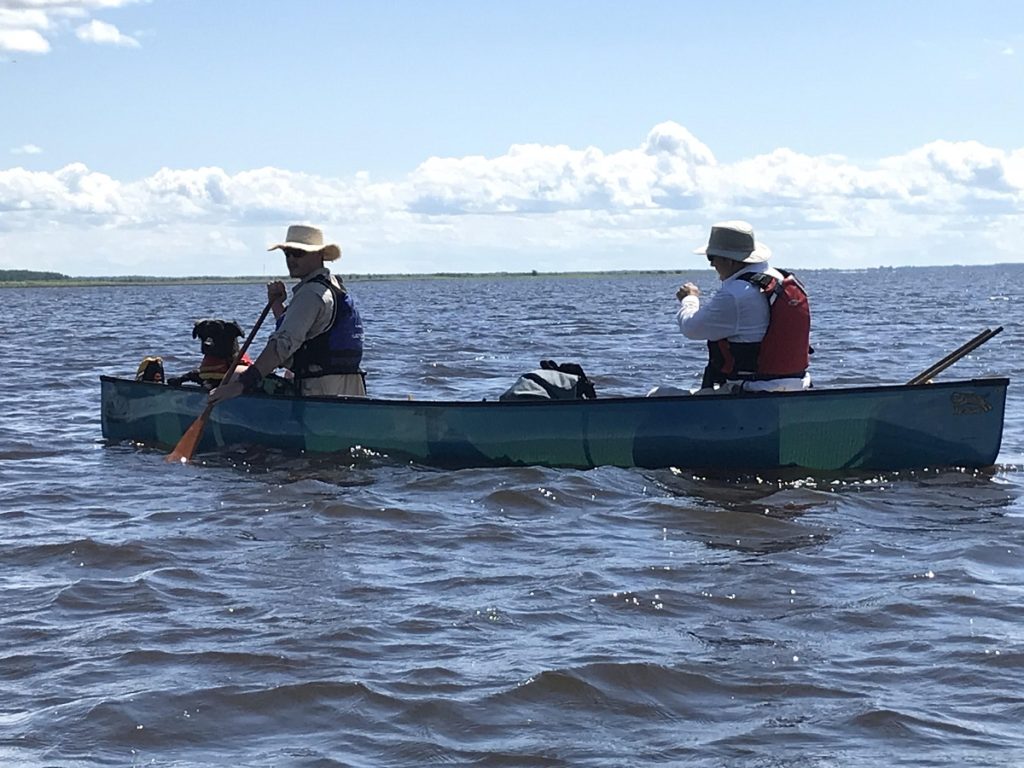


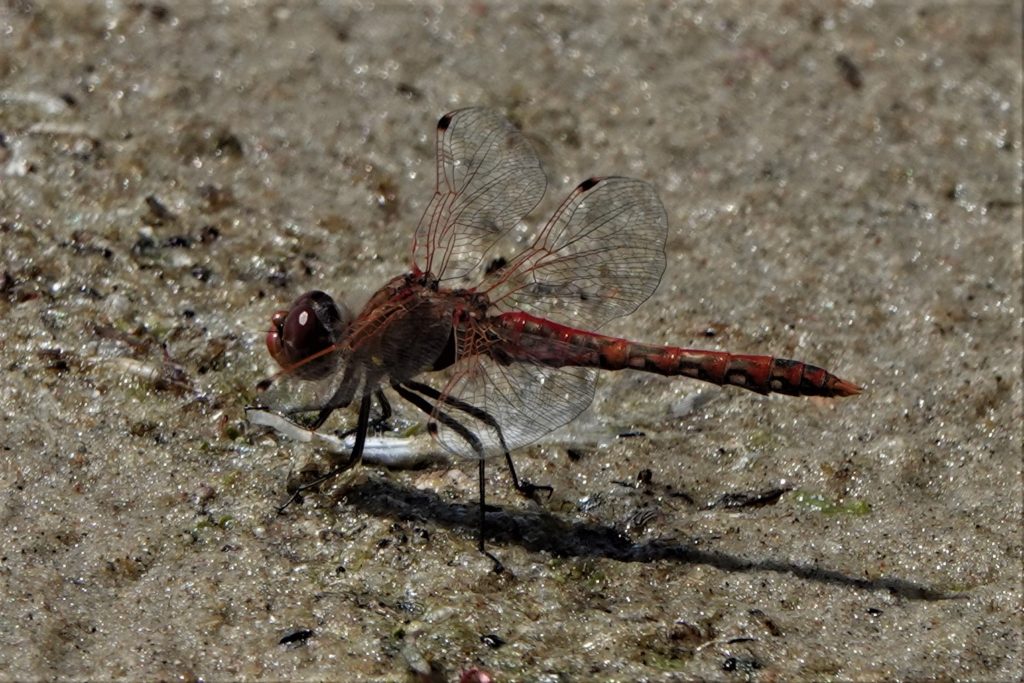

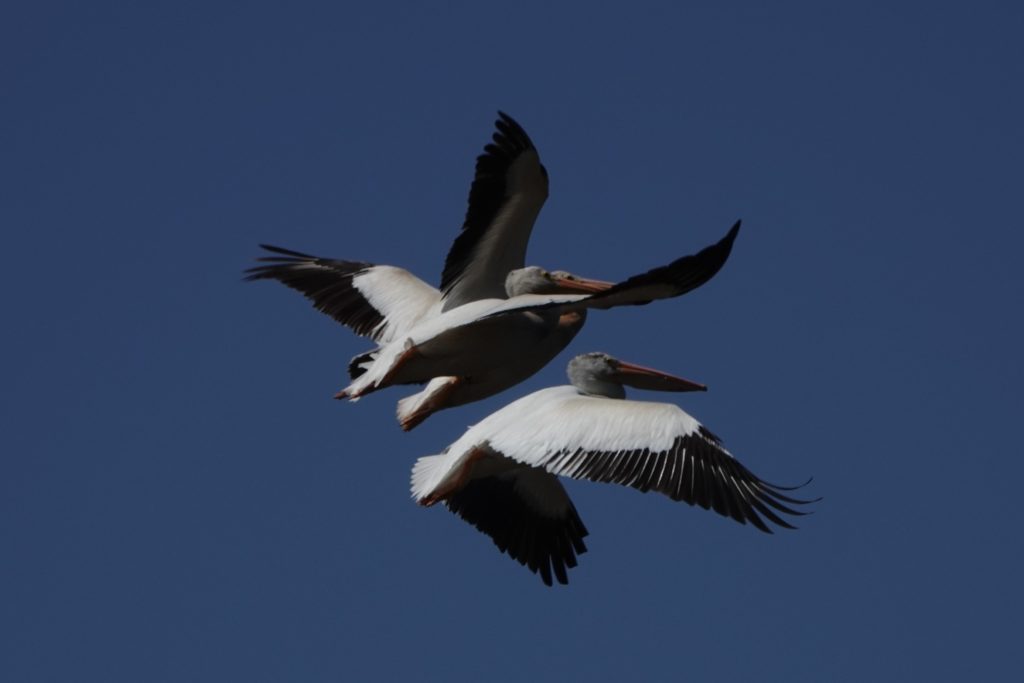
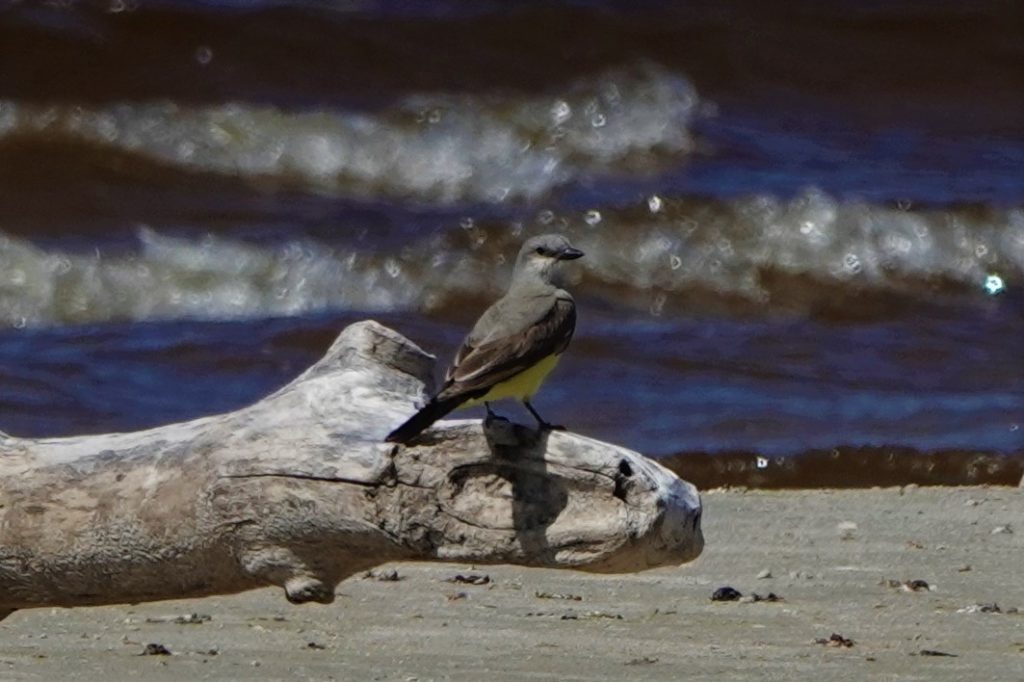
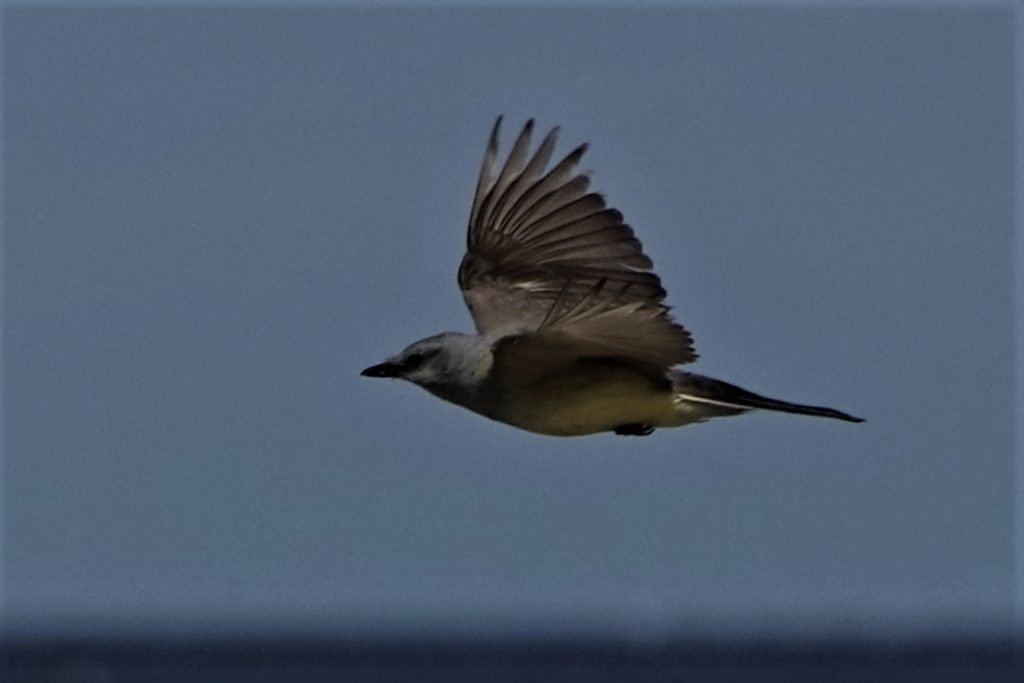

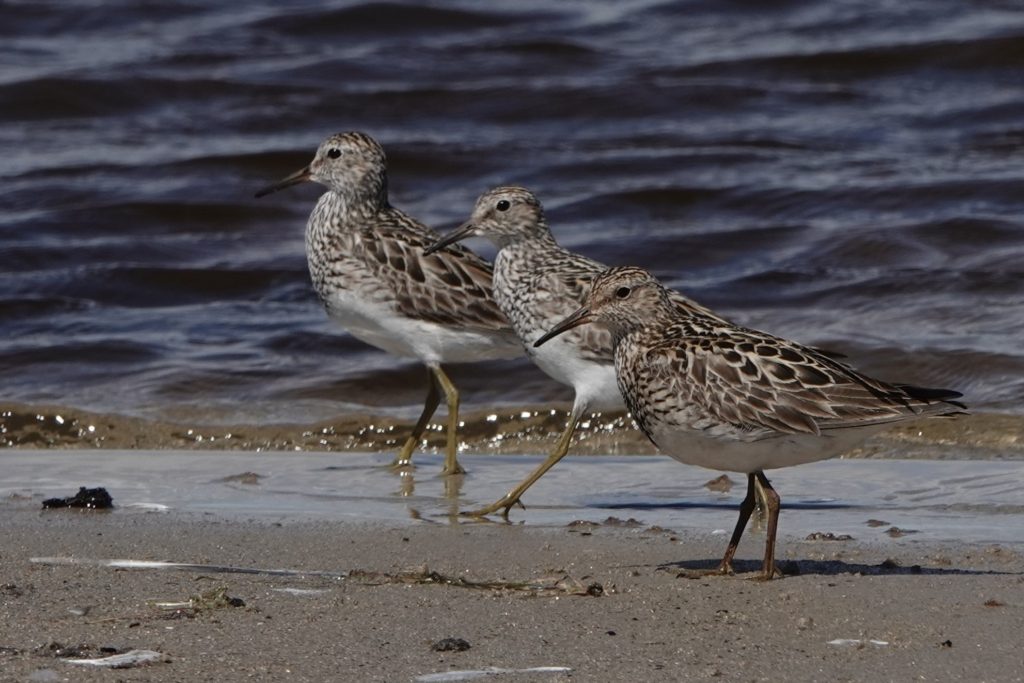

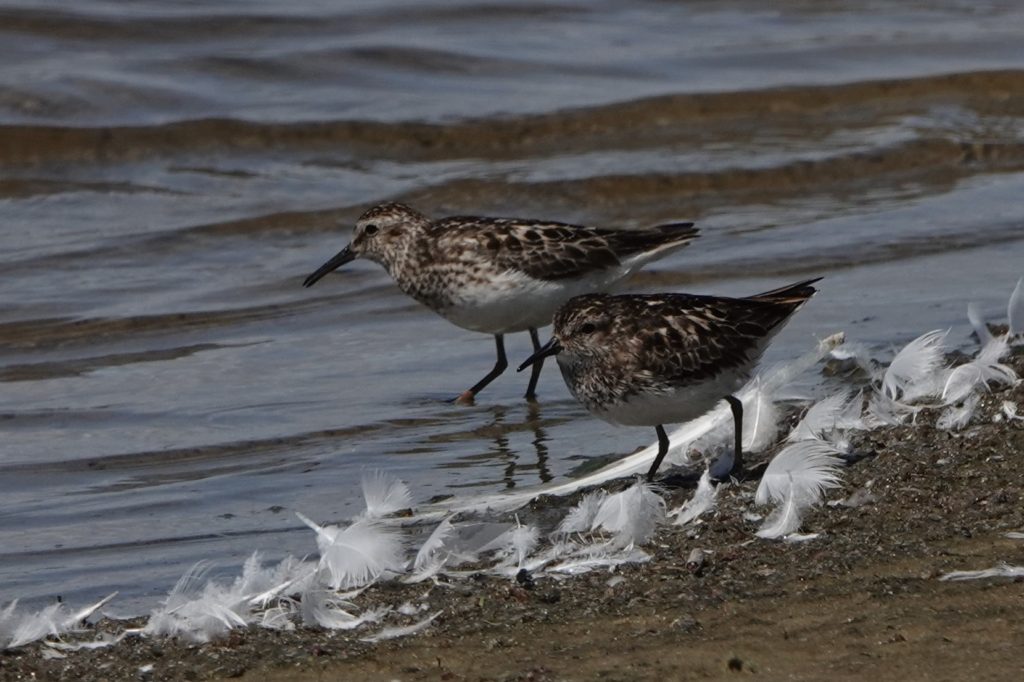
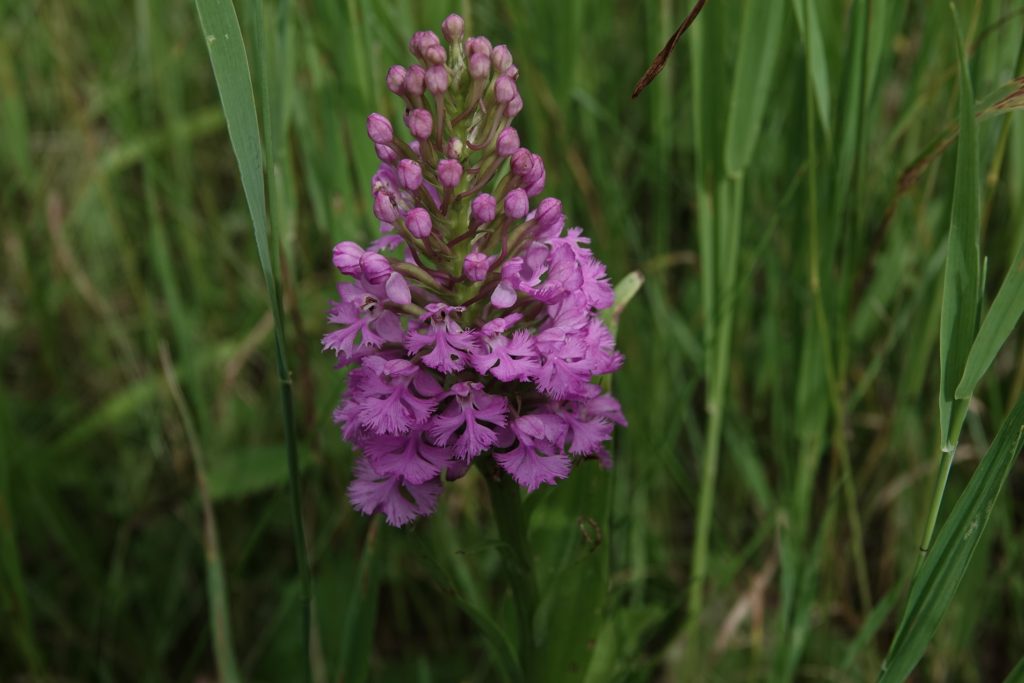
Wasaw Boffin Emo Odonate Trip
Since Sable Island netted us a new dragonfly record in early July, we were eager to get out again to see what else we might find. On July 25 Bob and Ilka visited Wasaw Lake, Boffin Lake, roads, beaver ponds and swamps in the area and then finished off the day in Emo along the waterfront and the Emo lagoon. Dragonfly watching in July and August, we are learning, is an athletic undertaking as they are not in the thick swarms of May and June and they tend to zip by at high speed on a long route. You might try the baseball batter stance, and wait for the dragonfly to come to you. Or you might try to run it down like a lacrosse player. If you miss, and you usually do, you’re in for a five to ten minute wait hoping that the dragonfly will swing by again. In the meantime, you get distracted and start chasing something else. Sometimes it is a smaller slower dragonfly, sometimes it is a bird or you see an interesting plant. Then suddenly there it is again, your quarry, and now your net is propped up against a nearby tree and you watch it zip by again as your face is hanging out.
The day did not disappoint. After checking out various logging roads and ponds, where there were River Jewelwings, Twelve-spotted Skimmers and other common skimmers we stopped in at the boat launch on the south end of Wasaw Lake and caught a Black-shouldered Spinyleg that was being stalked by a Dragonhunter. I think the coolest find there was a Shadow Darner that Bob caught in the shadows along the access road to the launch. At Boffin Lake we didn’t see much after catching a Dragonhunter at the beach, but after seeing quite a few Dragonhunter exuvia there in the flotsam we tried the kick nets in the water. We picked up a very tiny first instar Dragonhunter and let it go.
In Emo our first stop was to walk the waterfront downstream of the public dock. There are mudflats there that are perfect for clubtail nymphs to crawl up and emerge. Also, years ago during the Great Lakes Odonata Meeting the then new district record for Alkali Bluet was caught there. We soon found ourselves crouching in the grasses looking for exuvia as the water level was clearly higher when most clubtails emerged. We picked up about twenty exuvia and a few damselflies to identify later. Bob netted a Midland Clubtail.
We then parked up at the Emo lagoon. On that day you couldn’t swing a net without picking up several damselflies. There seemed to be millions so we focussed on trying to catch pairs in copula, as this is the best way of confirming the species of female bluets who otherwise can be very tricky. There were some tantalizing big darners and meadowhawks around, but the trouble with lagoons is that you really don’t want to get your feet wet to catch them. However, at some point we were pressed to get creative, as by the time we were about ¾ the way around our circumnavigation it was clear we had an unfamiliar mid-sized dragonfly just out of reach, hunting and scrapping with larger dragonflies about 6 feet from shore. They might be a rare or new record for the district so we couldn’t pass them up. Bob caught an errant one that swung into the shore, then we worked together so Ilka could lean out over the water and catch another without falling in the muck. In the end we confirmed that we have do indeed have Blue Dashers in the Rainy River District.
One of the addictive things about dragonfly watching is that it isn’t over when we climb back in the truck as we usually have photos, specimens or exuvia to look over. In this case, we had several dozen exuvia and the possibility of a dragonfly we hadn’t seen the same day. It is sometimes painstaking microscope work to figure these things out. You find yourself measuring the ratio between the length and width of some obscure body part and counting the antennae segments. But it is so worth it, as very often the exuvia we find are of the dragonflies we rarely see. We had picked up 20 Elusive Clubtails, 2 Boreal Snaketails and another new record for the district- the Arrow Clubtail.



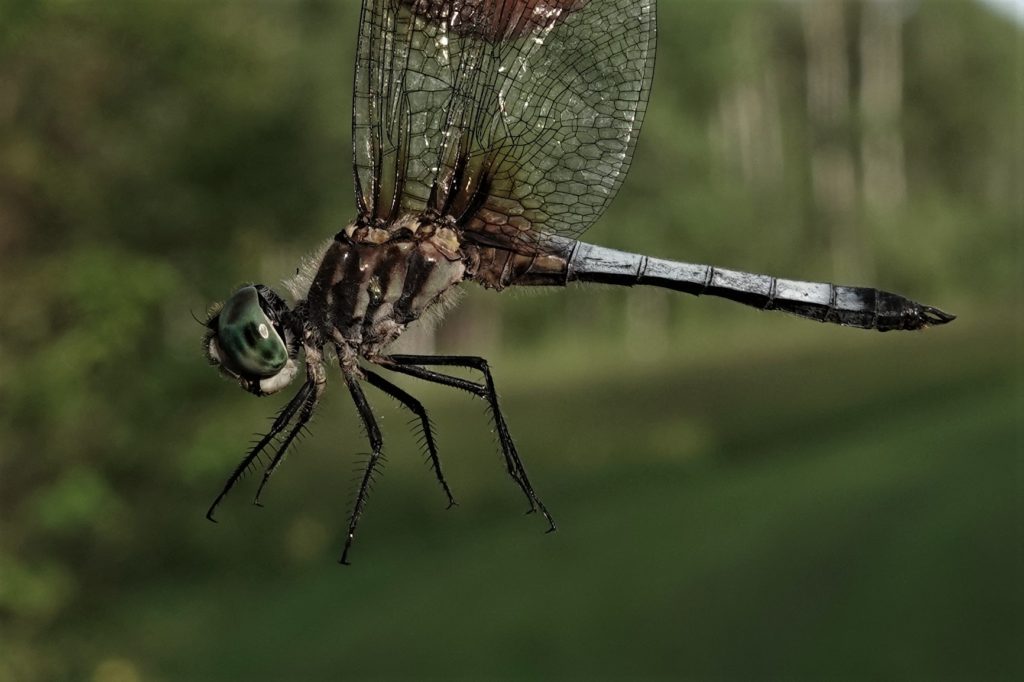

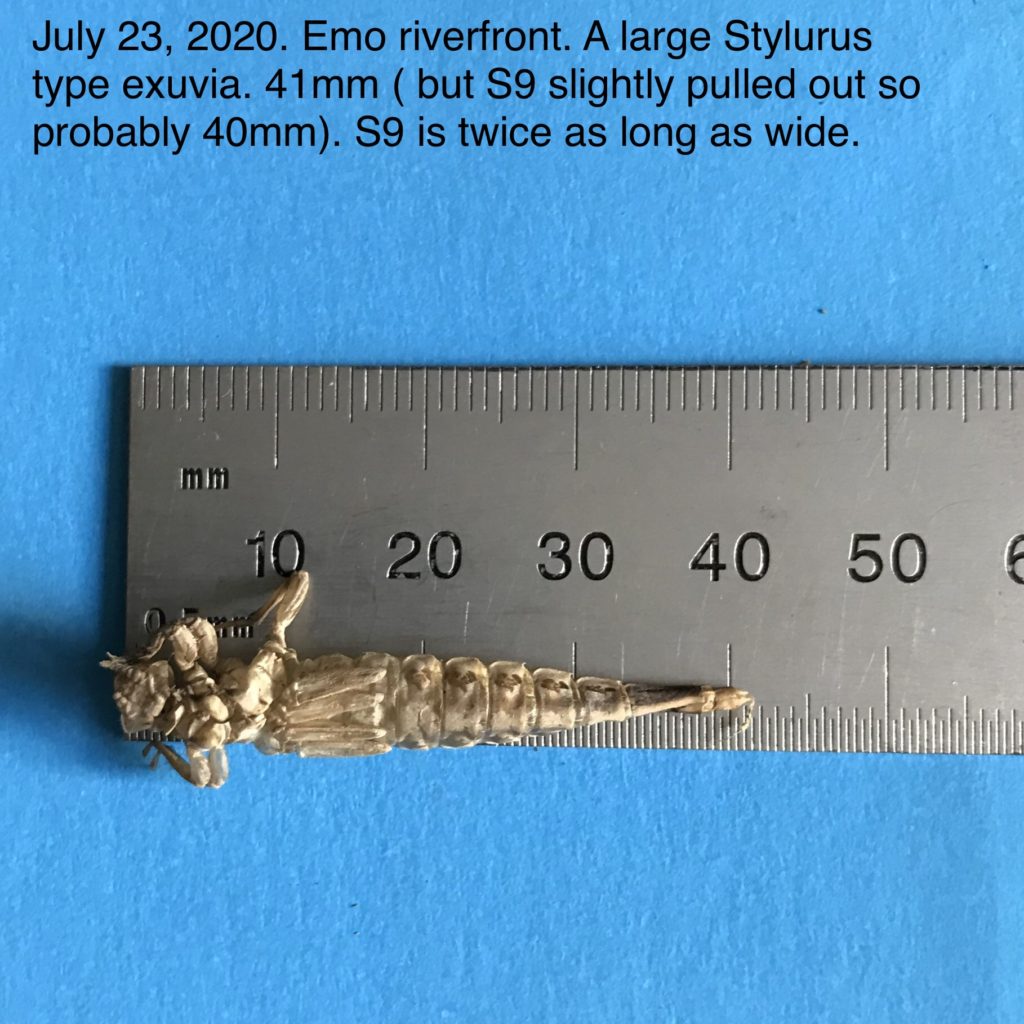



Oak Grove Field Trip August 2020
When the Nature Conservancy of Canada reached out to ask if any locals could check on their Oak Grove property, Rainy River Valley Field Naturalists had another reason for a west end field trip. Ilka Milne, Bob Saunders and Ahlan Johansen made a day of it, using the opportunity to bird and dragonfly watch on the way.
Just north of Oak Grove camp, Oak Grove is a roughly triangular shaped property, taking up the western half of the land north of Beckman Road and south of the mouth of the Rainy River at Lake of the Woods. It is open anyone who wants to walk around but in the twelve or so years since anyone has done any inventory work there the trails have grown in and are challenging to find. It is a stunning site, with pockets of towering White Pine and Red Pine over a stand of mixed Bur Oak and Hill’s Oak. The oak trees are more densely spaced than in a savannah, but their crowns are fairly open such that there is abundant light reaching the understory, where many interesting fruiting shrubs thrive.
The fun began at the Rainy River lagoon, where we saw many Mallards and Common Goldeneyes in a variety of ages and plumages, Blue-winged Teal, Wood Ducks and Canada Geese. A Northern Harrier flew over and perched by the forest edge. We called for a Sora, but none answered. Bob and Ilka pursued some darners and meadowhawks, but they were very difficult to catch as they seemed to be spending most of their time in the cattails in the water. The only two odonates identified were a Northern Bluet (Enallagma cyathigerum) and the lovely Saffron-winged Meadowhawk (Sympetrum costiferum) – which gets its name from the golden veins in the leading edges of its wings.
From the lagoon we worked our way north, stopping frequently along River Road, Wilson Creek Road and Oak Grove Drive to birdwatch. Bob’s trick of taking photos then zooming in to confirm identification was invaluable. With breeding done and young fledged most birds aren’t singing their territorial songs. Call notes and juvenile plumage made us work for our species count!
By the end of the day we had 47 species. Of particular interest were the Purple Martin nesting at Oak Grove camp, the many Eastern Wood Peewees and Warbling Vireos, the seeming super-abundance of Eastern Kingbirds and the many ways an American Goldfinch can sound like something else.
Oak Grove has signage at the east and west limits of the property on Beckman Rd. At the two former main trailheads are signs welcoming pedestrian visitors, but to find these you have to walk into the forest a bit. The trails are still quite clear by the indents in the ground and old sawn logs, but most of the flagging tape is gone. We tried to get the GPS to lay a track for us, but it couldn’t get signal through the canopy. The eastern trailhead is at the end of a clearing/vehicle pull out. The western trailhead is about 100 feet east of the property line.
We found the remains of the trail that branches off the main trail and takes you up to the upland oak-savannah/rock outcrop. As it was created to facilitate studying the property it isn’t very old and was never travelled by ATVs so it is narrow and less obvious, but it is probably frequently travelled by wildlife as the outcrop is well provisioned with berries and acorns. The acorn crop looks like it will be moderate to good this year but it was hard to tell if the blueberries produced much. If they did, they’ve been picked clean. There was fresh bear scat in the clearing and a gamey smell to the northeastern limit of the outcrop where wildlife have worn a path to the lower land.
The eastern property line was cut by Henriette Verhoef and associates at Bowman surveying about 20 years ago when the property was acquired for conservation. At the time some huge aspen had to come down, so it used to be very obvious from the road. We missed it, but found a narrow flagged footpath near where it probably is.
After spending several hours marvelling at the novel biodiversity just in the shrub layer, we resolved to go back again next year as a club event in May and June, when we expect to have birds, flowers and odonates in greater abundance.
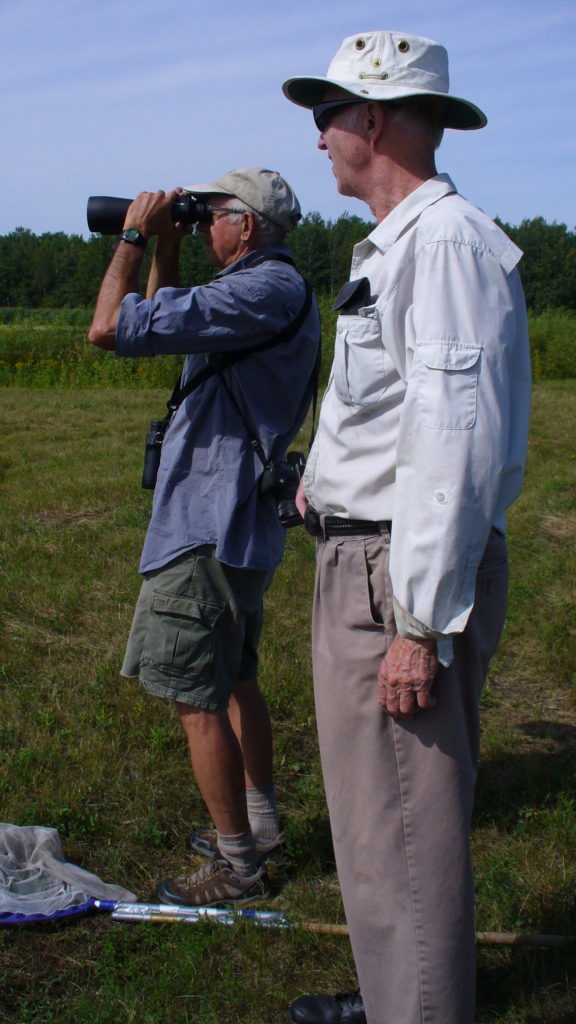





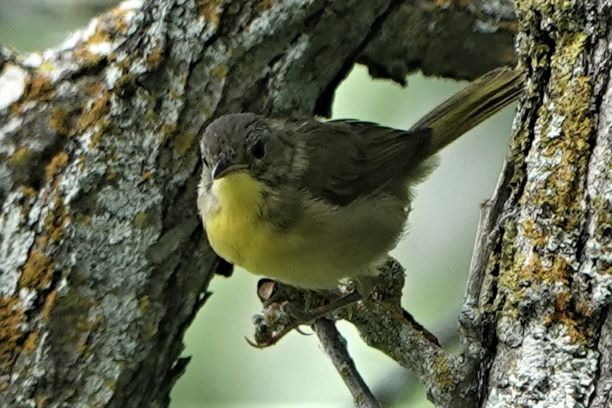
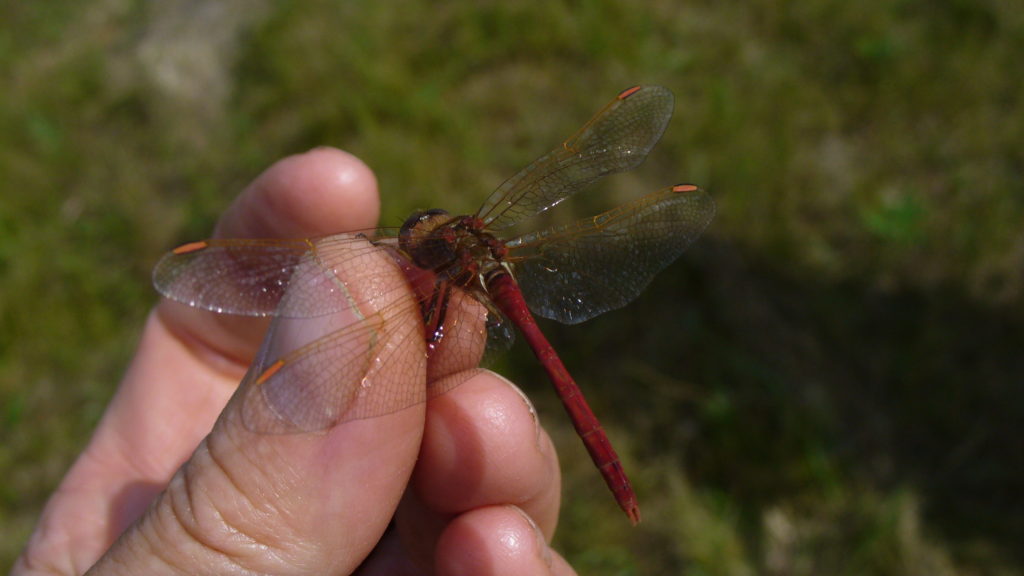
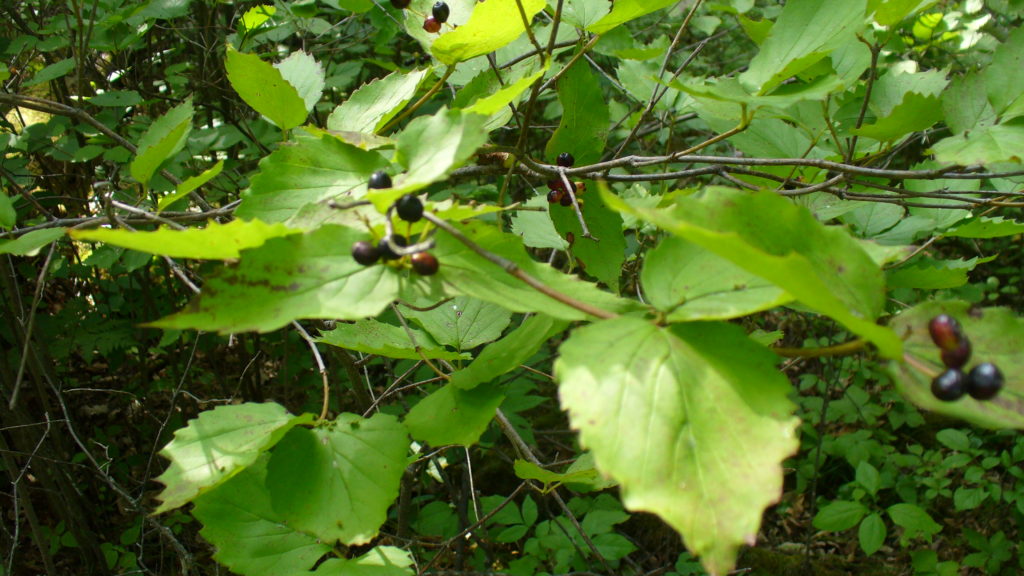


Bluebird Project Report
Night Sky
Comet NEOWISE

SUMMER ASTRONOMY TREATS
Article and photos by Fred Pugh
Now that we are well past the summer solstice the warm, dark nights of August are the perfect time to get out and explore the solar system. During August four of the 5 bright planets are well positioned and visible with the naked eye. The annual Perseid Meteor Shower peaks from August 11-13 and of course there is the moon.
Moon
Because the orbit of the Moon is not circular, a full Moon can occur when it is as far from the Earth as it can get ( apogee ) or as close as possible ( perigee ). The difference between a so called super Moon and a mini Moon is only approximately 14 percent. This size difference is very difficult to detect but is easily confirmed with photographs so if you have found yourself disappointed by all the hype over a super Moon you are not alone. If you hold your thumb at arms length you can completely cover the Moon which averages .52 angular degrees. This is a handy measurement to keep in mind to help find other deep space objects. Another handy measurement to use is a clenched fist held at arms length which equals approximately 10 degrees. Binoculars will bring out all kinds of detail on the Moon such as craters, mountains and seas. The different phases of the Moon will highlight different features because of the angle of the light and shadows which can create a 3D effect so look often.


Jupiter
Jupiter, the largest planet, can be found in the southern sky after dark in the constellation Sagittarius and is easy to spot because it is the brightest object in that part of the sky after the Moon which on some nights will be near by. Jupiter has 79 moons and binoculars will reveal the largest 4 of them. From innermost to outermost they are Io, Europa, Ganymede and Callisto. These 4 moons perform an amazing dance around the planet and you can easily see their positions changing over the course of a night. The planet itself rotates very quickly on it’s axes with a Jovian day lasting only 10 hours. Some binoculars will also show banding on the planet itself. A small telescope reveals many bands as well as the Great Red Spot which is a huge storm larger in size than the Earth that has been raging for centuries.
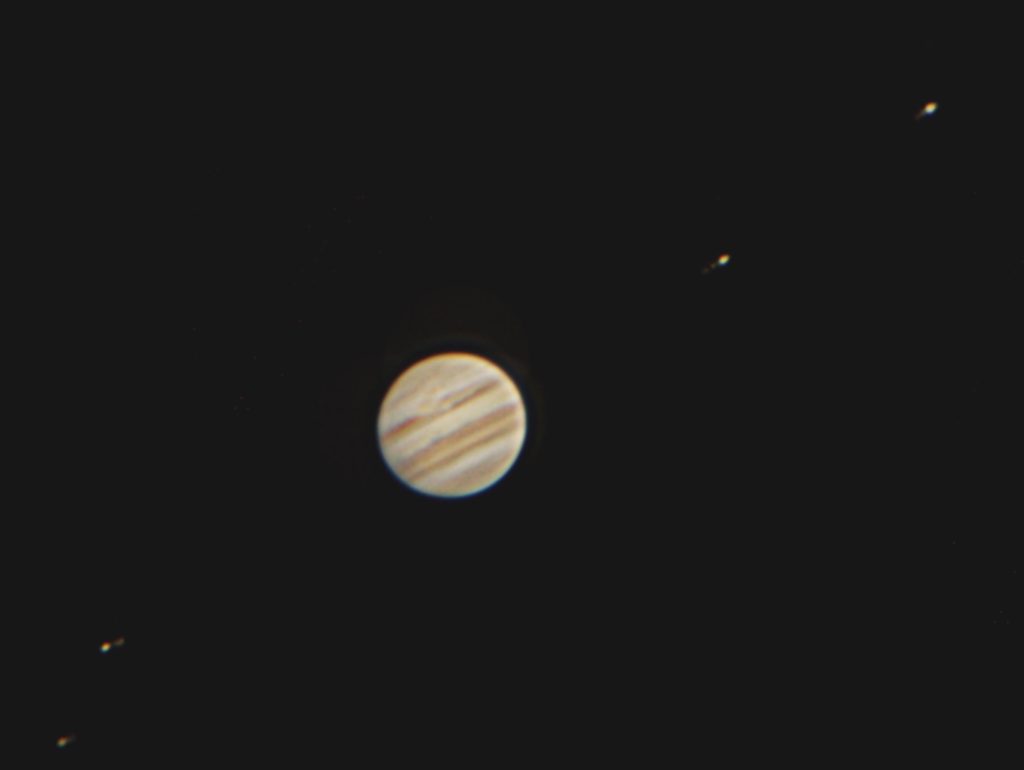
Saturn
Saturn, the second largest planet, can also be found in the southern sky after dark in the constellation Sagittarius approximately 8 degrees east of Jupiter ( remember a clenched fist held at arms length is approximately 10 degrees ). Saturn is not as bright as Jupiter but is a beautiful golden colour and is very easy to spot. Saturn has 82 moons but only one, Titan is large enough to be seen in some binoculars by experienced observers. You probably will not see Saturn’s rings in binoculars but you may notice that it is not round. Any small telescope will reveal Saturn’s rings and for many, seeing the rings of Saturn for the first time is a most memorable experience
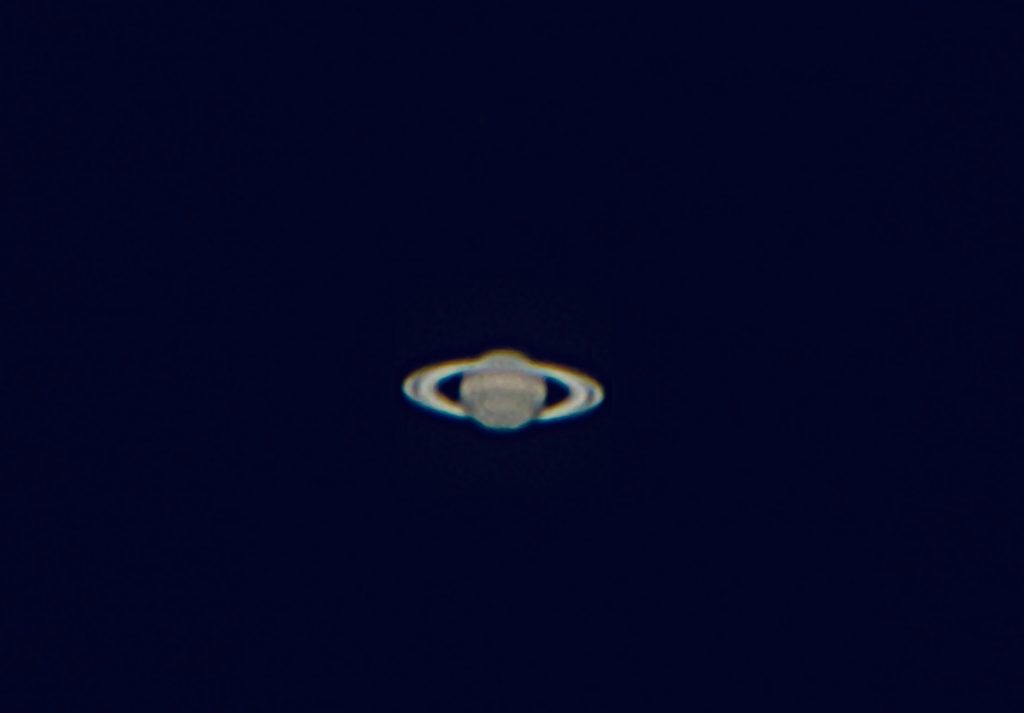
Mars
Mars is a small ruddy red world that is rising in the east among the stars of the constellation Pisces and will almost double in brightness during August as Earth slowly catches up to Mars in its orbit. By the end of August the disc of Mars will be 40 percent the size of Jupiter’s disc but is still too small to see any detail with binoculars. A telescope is needed to see some of the surface features on Mars. On the night of August 8 just before midnight you will see the waning gibbous moon in the eastern sky accompanied by brilliant Mars 2 1/2 degrees to the moons upper left. The pair will make a magnificent sight

Venus
Venus is often called the morning star or the evening star. Its orbit lies closer to the Sun than Earth’s so much of the time Venus is lost in the Sun’s glare. It becomes observable only for a few months when it reaches its greatest separation from the Sun, called greatest elongation. During these occasions Venus is so bright that it becomes the 3rd brightest object in the heavens after the Sun and Moon. The planet is permanently shrouded by cloud cover so no surface details can be seen, however Venus goes through phase changes similar to the Moon and these phases can be seen in binoculars
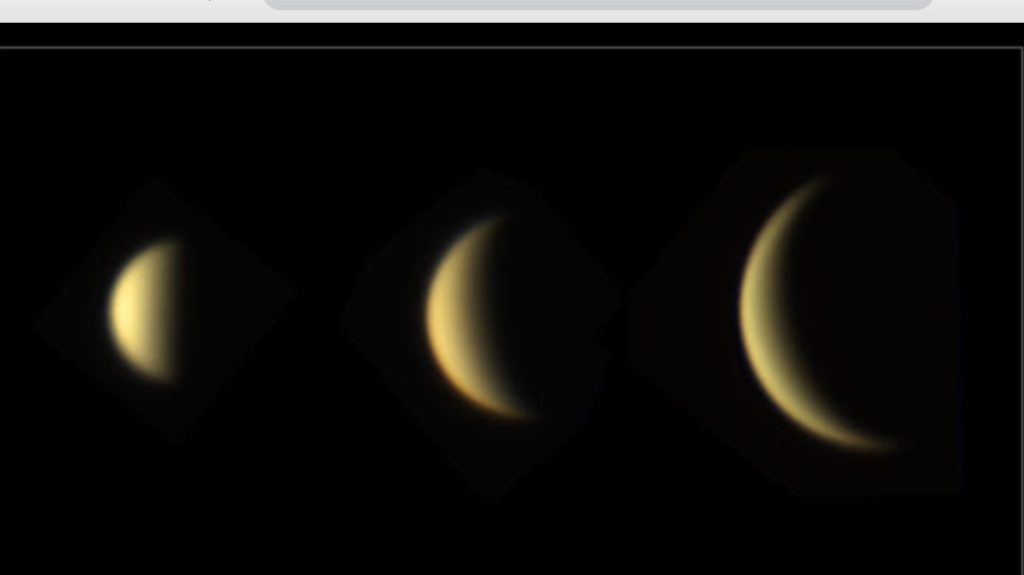
Perseid Meteor Shower
The Perseids are one of the best meteor showers of the year in the northern hemisphere and the peak is expected during the late evening hours until dawn on August 11 and into August 12. The meteors originate as tiny debris from comet Swift-Tuttle and appear to radiate from the constellation Perseus but you will be able to see them in all parts of the sky. Unfortunately there will be a last quarter moon in the sky but it should not detract too much from the spectacle. Dress warm, bring a thermos of hot chocolate, give your eyes plenty of time to adjust to the darkness and enjoy the show. It should be noted that for several days before and after the peak there will be a much elevated number of meteors so if conditions are unfit on the peak dates don’t give up. It will be worth it.
100 per hour…….um, not quite
By Bob Saunders
This would be the night. I had it covered. Clear skies. No moon until after midnight, and then, only a quarter moon. I would go out after ten and again before dawn. I couldn’t miss.
Accordingly, I set my alarm for 3:15 before going out shortly after 10 pm. The Summer Triangle was directly overhead, Cassiopeia to the northeast with Perseus, Andromeda, and Pegasus low in the sky, mostly hidden by the ring of trees around the open field in front of my cabin. Saturn and Jupiter were shining brightly in the southern sky, and the Milky Way was shimmering. I settled down in a lawn chair with my binoculars, prepared to spend a pleasant evening oohing and ahhing.
Well, I did see three good meteors streaking across the sky In half an hour of viewing. Perhaps I missed some while looking through the binos for favourite star clusters. But satellites! My goodness, they were everywhere!
No problem. I wasn’t expecting that many so early in the evening. The main meteor swarm was supposed to be in the hours before dawn, so off to bed. I had an odd dream during the night, which in hindsight was probably my unconscious self telling me to stay in bed. I dreamt I was in my boyhood home and had planned to get up at 3:15 to watch the meteor shower. I fumbled for my watch to see what time it was, couldn’t at first see what time it was, as the light on the watch wouldn’t come on. Eventually I determined it was 3:12, time to get up. I dressed but when I stepped outside it was snowing, although oddly, there were patches of clear sky here and there. It was obvious I wouldn’t be able to see any meteors, so decided to go back to bed. At this point I woke up and wondered what time it was. I was rather confused because the dream had felt so real. I checked my watch (no problem with the light) and saw that it was 3:12 (something very strange is happening). I thought about this for a minute or so until my mind became clearer, got up, dressed warmly, grabbed my binos and lawn chair, and headed outside (and no, it wasn’t snowing).
Now, the quarter moon was up in the east, reddish Mars had replaced Saturn and Jupiter in the southern sky, the Summer Triangle had moved to the west with Aquila just visible below the tops of the tree, and Cassiopeia, along with Andromeda, Perseus and Pegasus directly overhead. The Big Dipper was low in the northern sky and Arcturus was no longer visible (“follow the arc to Arcturus”). The Pleiades were obscured by the light of the nearby moon, but could easily be seen with binoculars. Not far away were the red giant Aldebaran in Taurus and the constellation Auriga close to the horizon below Cassiopeia. Orion hadn’t risen yet. The Milky Way was now spread across the sky from the east to west.
I settled in and began waiting…..and waiting. In the half hour or so I spent watching the sky I eventually did see 5 meteors (4 quite good) but a far cry from the oohs and ahhs I was both expecting and hoping for. I might have missed some while viewing objects and satellites with the binoculars.
Was I disappointed? A bit. But it was so enjoyable just viewing the night sky and seeing how it was transformed as the night progressed. Normally I’m in bed when the stars are at their brightest, so it was wonderful to connect with them again.
And there is always tomorrow.
A Beginner’s Introduction to the Summer Constellations
By Bob Saunders
I’ve been photographing the night sky the last few clear nights with my limited skills and equipment, mostly to refresh my memory of the locations of the various constellations visible at this time of year, and I thought others might be interested, as well. Owing to the rotation of the earth, its axis, and so on, the sky changes as the night and the seasons progress. The photos were taken from around 9:30 pm to nearly midnight. They would look quite different if taken just before sunrise, in fact, an entire season would have moved forward.
For those interested in learning the constellations, my suggestion would be to start by viewing, in the northern sky, the Big Dipper, which everyone is familiar with. It is part of the Ursa Major constellation. From there follow the pointer stars (the upper and lower right hand stars of the dipper) to Polaris. Polaris is part of the Ursa Minor constellation, which isn’t particularly easy to pick out. But it is an important star, around which our circumpolar constellations revolve. Those constellations can be seen the entire year from southern Canada. Draco snakes it’s way between the two dippers, swinging around and above the Small Dipper (Ursa Minor),
stopping near the top of Hercules.
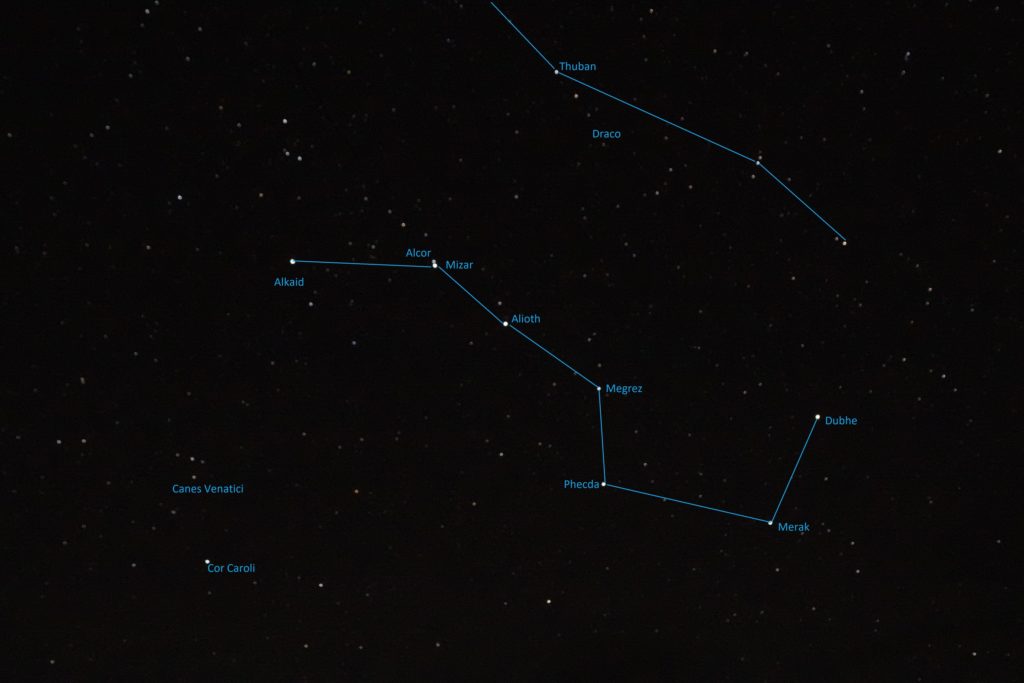
The Big Dipper
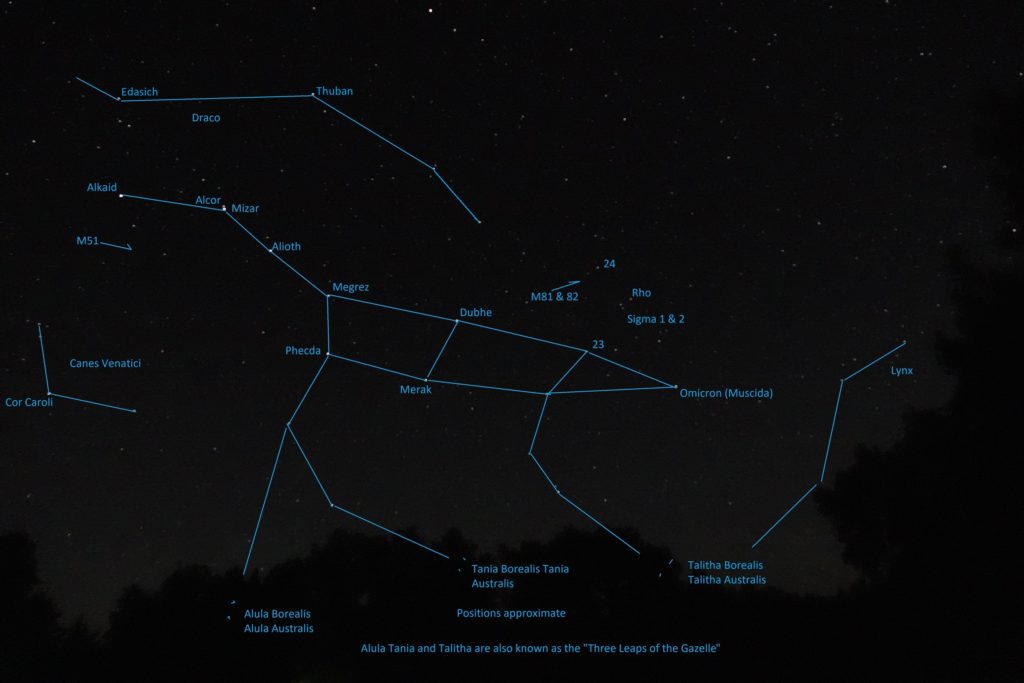
Ursa Major

Draco,Ursa Minor, Cepheus and Cassiopeia
From Polaris, just to the east, is Cassiopeia (the Queen), the obvious W-shaped constellation. Above Cassiopeia, beginning close to Polaris is Cepheus (the King), below are Perseus and Andromeda. Andromeda leads into Pegasus, a bit further to the east. The Great Square of Pegasus is easily picked out. Continuing east into the southern portion of the sky, low to the horizon are part of Pisces, directly below the Great Square, Aquarius and Capricorn.
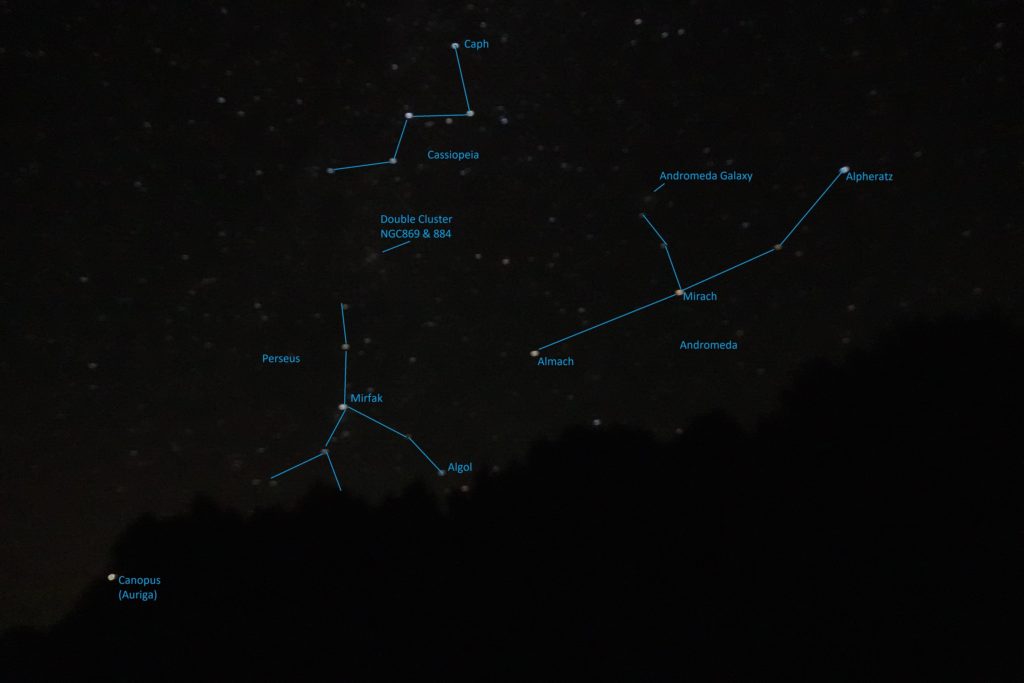
Perseus, Cassiopeia and Andromeda

Pegasus, Pisces and Aquarius
Now look up, way up (as the Friendly Giant used to say to those of us now well-advanced in years) to the Summer Triangle, the centre piece of the summer night sky. The Summer Triangle is formed by three stars from three different constellations, Vega in Lyra and directly overhead, Deneb in Cygnus, the furthest star of the group to the north, and Altair in Aquila, to the south.
Within the Summer Triangle are a few interesting constellations and star clusters (Delphinus, Sagitta and the “Coathanger”, all best seen with binoculars, the latter looking more like a teeter-totter than a coat hanger to me), and one rather uninteresting constellation, Vulpecula, which is just below Cygnus and above Sagitta.
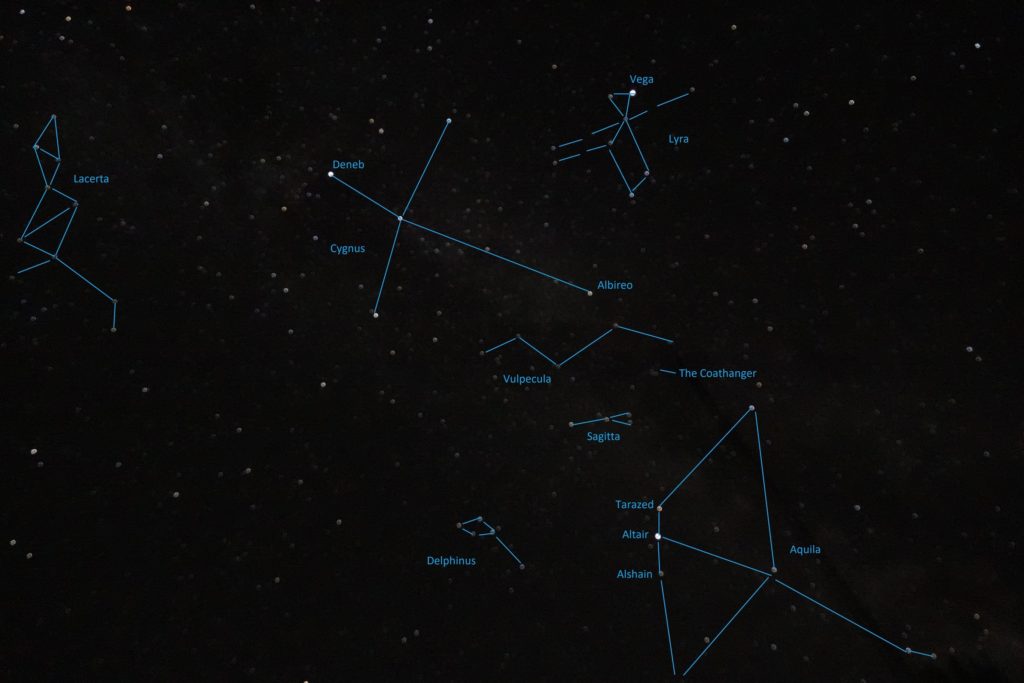
The Summer Triangle: Deneb (in Cygnus), Vega (in Lyra) and Altair (in Aquila)
Below Aquila (and currently near Jupiter) is Sagittarius, with its familiar tea kettle shape. As you look here, you are looking directly into the centre of the Milky Way Galaxy, our home. As a result, that area happens to be a rich area for Messier objects.
Charles Messier was a comet hunter of the 1700’s who wasn’t interested in nebulas, star clusters or other galaxies but which looked very much like comets. So, to avoid confusion and wasted time (much like learning to recognize the song of a House Sparrow so you can quickly move on to more interesting birds) he created a table of
those objects. He numbered those objects, the prettiest in the sky, quite haphazardly. In the 1800’s The New General Catalogue (NGC) was created, and objects were ordered from west to east across the sky. Messier objects and NGC’s are often what amateur astronomers, like our night sky correspondent, Fred Pugh, are aiming their telescopes at. I’ve included a few Messier objects, but they are beyond the scope of this email.
Above Sagittarius and to the right of Aquila is Ophiuchus, the doctor, holding the head and tail of Serpens, the snake. Ophiuchus is often identified with the god Aesculapius, the first doctor of medicine. The staff of Aesculapius, wound with serpents remains a symbol for medicine,
Near Ophiuchus is Barnard’s star, which is the closest star to our own solar system visible from the northern hemisphere. Alpha Centauri is
closer but is visible only in the Southern Hemisphere. Don’t bother looking for it – it’s only visible in a telescope.

Capricorn, Sagittarius and Ophiuchus

Ophiuchus
Above Ophiuchus is Hercules, his foot near Corona Borealis, another easily recognized constellation which can be used to find both Hercules to the left and Bootes, a kite-shaped constellation to the right. Moving on, we are now back to the Big Dipper (and a couple more small constellations, Canes Venatici and Coma Berenices).
As for what these constellations are supposed to represent, I’ll leave that for another time. Otherwise this article will become far to long!
A word of warning. If the night is crystal clear, there will be so many stars visible that it may become difficult to pick out the constellations. Also, binoculars are better used to pick out smaller constellations or star clusters that fit into the field of view. You will easily get lost trying to find your way in the larger constellations.

Hercules and Corona Borealis

Hercules and Corona Borealis

Hercules, Corona Borealis and Bootes

Bootes, Coma Berenices, Canes Venataci